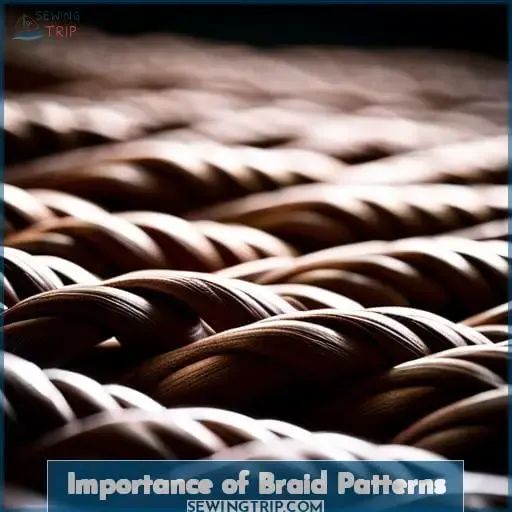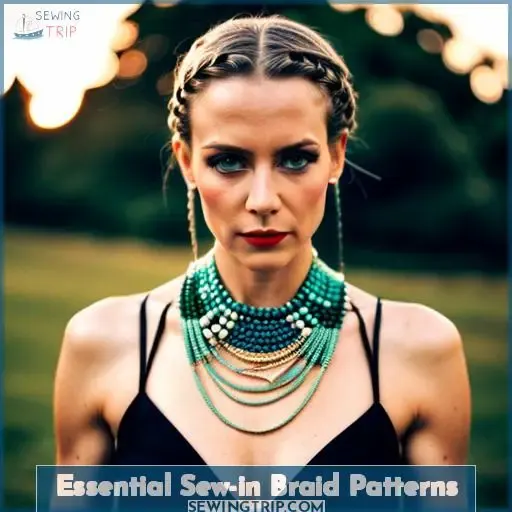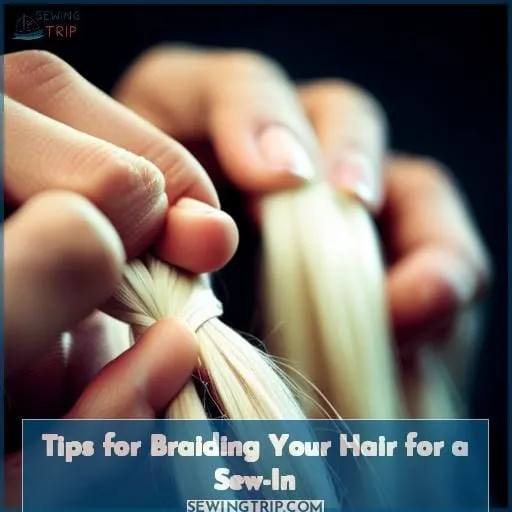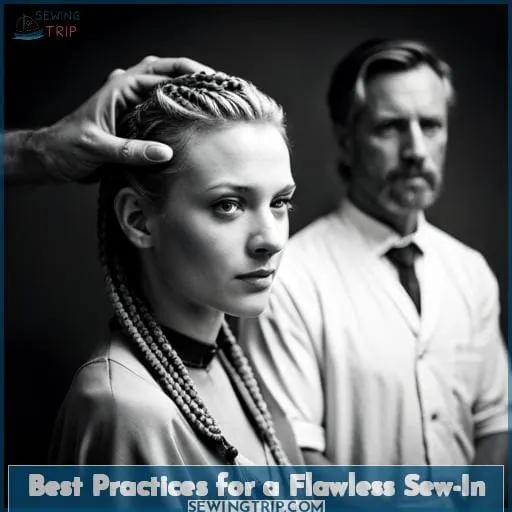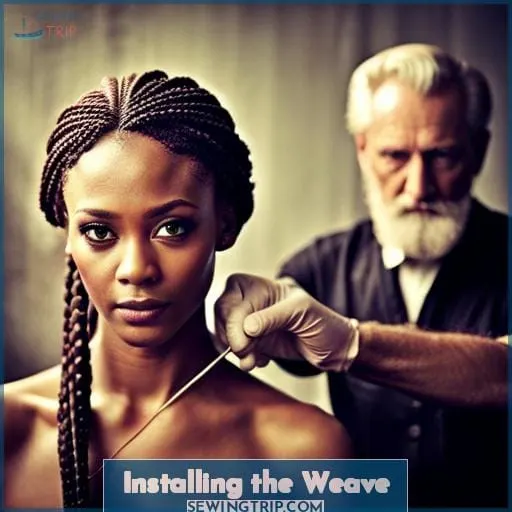This site is supported by our readers. We may earn a commission, at no cost to you, if you purchase through links.
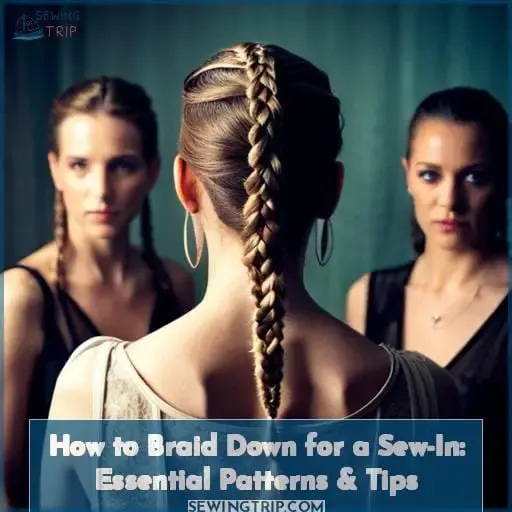 Picture this:
Picture this:
You’re ready to rock a fabulous sew-in, but before you can install those gorgeous extensions, you need to braid down your natural hair.
Don’t worry, we’ve got you covered! In this article, we’ll show you essential patterns and tips for braiding down your hair for a flawless sew-in.
Whether it’s the 4-Way Vixen Pattern or the Zig-Zag Pattern that catches your eye, we’ll help you choose the perfect braid pattern and guide you through the process step by step.
Get ready to slay with confidence!
Table Of Contents
Key Takeaways
- Importance of choosing the right braid pattern for sew-ins
- Tips for braiding, including trimming ends and avoiding tight braids
- Best practices for flawless sew-ins, such as regular washing and using hot oil treatments
- Overall guidance on balancing aesthetics, skill, and hair care in the sew-in process
Importance of Braid Patterns
When preparing for a sew-in, it’s crucial to understand the significance of choosing the right braid patterns. The foundation of your style lies in the braid pattern underneath. Consider versatility for styling, parting preferences, and tension distribution.
Select patterns like straight-back without leave-out for beginners, while more advanced options allow layers and permit diverse parting. Analyze your braiding skill, weaknesses requiring coverage, and desired aesthetic.
Straight-back cornrows distribute tension evenly across the head. Braiding techniques should be flat and smooth for natural appearance. Choose patterns wisely, as this groundwork impacts styling potential, safety, and flawless execution.
Essential Sew-in Braid Patterns
When braiding hair for a sew-in weave, the braiding pattern you choose is crucial. There are several go-to braid patterns that work well as a base for sew-in weaves, allowing versatility in styling.
Let’s explore some top essential braid patterns to use when braiding down for your next flawless sew-in.
4. Way Vixen Pattern
Versatility defines the 4-Way Vixen braid pattern for sew-ins, giving you extreme freedom in styling options. With this pattern, you can achieve various looks and experiment with different hairstyles.
Here are some reasons why the 4-Way Vixen pattern is a popular choice:
- Allows for face-framing layers
- Provides tension relief on your scalp
- Ensures a neat and secure foundation for your sew-in
- Perfect for braiding patterns used in full sew-ins
Zig-Zag Pattern
The zig-zag braid pattern’s diagonal criss-crossing allows you multiple styling and parting possibilities.
Opt for this versatile technique when desiring angled hairdos with dimensional layers.
The zig-zag’s beginner-friendly nature provides options from subtle dimension to dramatic swooped bangs.
By braiding down in this dynamic pattern before sewing in your weave, you enable diverse styling with layered parting on the crown, sides, even bangs.
Feel empowered to embrace versatile dimension by zig-zag braiding when preparing to sew in hair.
Straight-Back Without Leave-Out
To achieve a secure and natural-looking sew-in style, master the Straight-Back Without Leave-Out braid pattern. This beginner-friendly approach ensures a protective and flawless foundation for your sew-in.
By braiding your hair in straight back cornrows without leaving any hair out, you create versatility in styling options while maintaining a natural appearance.
Enhance the longevity of your sew-in with this simple yet effective technique that caters to both beginners and experienced stylists alike.
Diagonal Pattern
For a more unique and dynamic sew-in style, consider opting for the diagonal pattern when braiding down your hair.
The diagonal pattern adds a touch of angled elegance to your look, creating stunning visual appeal.
This braid pattern allows for versatile styling options, whether you’re going for sleek straight styles or dramatic curls.
With careful precision in creating the diagonal braids, you’ll achieve tension relief and ensure that your sew-in weave stays securely in place while adding some captivating diagonal drama to your overall hairstyle.
Beehive Pattern
Create a beehive pattern for your sew-in by strategically braiding your hair in spiral formations around the head.
This unique braid pattern offers volume control, allowing you to achieve fuller and more voluminous styles.
The beehive pattern also provides styling versatility, as it can be easily transformed into elegant updos or creative hairstyles.
With limited parting options, this braid pattern ensures a sleek and polished look that exudes sophistication and elegance.
Factors to Consider When Choosing a Braid Pattern
When choosing a braid pattern for your sew-in, there are several factors you should consider.
First, think about your parting and styling preferences. Do you want the flexibility to switch up your style or do you prefer a more structured look?
Additionally, consider protecting weak areas by selecting patterns that distribute tension evenly.
Lastly, evaluate your own braiding ability and choose patterns that align with your skill level to ensure a successful installation.
Types of braid patterns
When choosing a braid pattern for your sew-in, consider factors such as:
- Parting preferences
- Protection of weak areas
Different patterns offer varying levels of styling versatility and tension management.
- Straight-back with leave out
- U-part with leave out
- Vixen braiding pattern
- Beehive braiding method
- Asymmetrical braiding pattern
Each pattern has its own unique benefits when it comes to achieving the desired look while ensuring the health and protection of your natural hair.
Factors to consider
When choosing a braid pattern for your sew-in, there are several factors you should consider.
First, think about tension management and choose a pattern that distributes the weight evenly to prevent discomfort or damage.
Next, consider styling versatility and select a pattern that allows for different parting options and hairstyles.
Additionally, prioritize protective foundations by opting for patterns that cover weak areas of your hair or scalp.
Lastly, assess your personal braiding ability and choose patterns with an appropriate level of complexity based on your skill level.
Tips for braiding
Consider your styling preferences and the protection needs of your hair when choosing a braid pattern for your sew-in.
To ensure a successful and comfortable installation, it’s important to follow some key tips for braiding:
- Trim ends before braiding to prevent breakage and tangles.
- Add synthetic hair for tension relief and added structure.
- Avoid tight braids that can cause discomfort or damage.
- Braid as flat as possible to achieve a smooth and natural appearance.
Prioritize the health and protection of your hair throughout the process.
Tips for Braiding Your Hair for a Sew-In
To achieve a flawless sew-in hairstyle, start by braiding your hair with precision and care.
- Use the right tools:
- Gather all the necessary braiding tools such as a rat-tail comb, clips, and elastic bands to help section and secure your hair during the process.
- Choose suitable products:
- Invest in high-quality braiding products like edge control gel or pomade to keep flyaways at bay and maintain sleek edges throughout the styling process.
- Master proper technique:
- Practice different braiding techniques such as cornrows or box braids before attempting them for your sew-in. This will help you develop dexterity and create neat sections that are essential for achieving an even installation.
Best Practices for a Flawless Sew-In
To achieve a flawless sew-in, follow these best practices for optimal results.
Maintenance techniques are crucial to ensuring the longevity and appearance of your sew-in hairstyle.
Make sure to wash your hair regularly using diluted shampoo in a squeeze bottle, focusing on getting to the braids under the tracks during washing.
Incorporate hot oil treatments for both your natural hair and extensions every 1.
Styling variations are another key aspect of maintaining a flawless sew-in.
Use styling tools like flat irons or curling irons to blend your natural hair with the extensions seamlessly, paying extra attention to roots and new growths.
Haircare routines should include trimming ends before braiding down for added protection against breakage and tangles.
Additionally, consider using synthetic hair as it provides tension relief while adding structure.
By following these best practices such as maintenance techniques, styling variations,and protective measures,you can ensure that you have a flawless sew-in that’s long-lasting and looks amazing!
Prepping Your Natural Hair
Before installing the weave, it’s important to properly prep your natural hair.
Prepping your natural hair sets the foundation for a successful sew-in and ensures that your hair remains healthy throughout the process.
Start by washing and conditioning your hair to remove any build-up or dirt. This won’t only promote scalp health but also allow for better moisture retention.
Choose a suitable braid pattern that suits both your desired style and protects weak areas of your scalp from excessive tension.
When braiding, make sure to be gentle yet secure so as not to cause damage or discomfort during installation.
Taking these steps will help maintain the overall health of your natural hair while enjoying beautiful protective styling with a sew-in weave.
Installing the Weave
You measure the track for the first row from one side of the braid to the next after prepping your natural hair.
Installing techniques are crucial for achieving a realistic sew-in that seamlessly blends with your natural hair.
-
Cut and Sew:
- Cut the track to match the length needed.
- Sew it onto your braids using weaving thread.
- Start with one row, measuring carefully from braid to braid.
-
Systematic Approach:
- Continue sewing each additional row, working from left to right for consistent placement.
- This method ensures an organized and professional finish.
-
Secure Attachment:
- Make sure each track is securely attached by stitching through multiple points on both sides of the weft, minimizing any risk of unraveling or slippage.
By following these steps during installing, you can achieve optimal weave blending while maintaining proper attachment techniques for long-lasting results in styling integration.
Frequently Asked Questions (FAQs)
How long should I leave my hair braided before installing the sew-in?
For optimal results, it’s recommended to leave your hair braided for at least 1-2 days before installing the sew-in.
Can I use a different color or texture of weaving hair than my natural hair?
Absolutely! Choosing hair in a different color or texture than your natural hair opens up so many fun styling possibilities. Just ensure the extensions blend smoothly with your leave-out hair for a flawless, seamless look.
What should I do if my braids start to feel too tight or uncomfortable?
If braids start feeling too tight, take them out right away. Leaving them in risks damage.
Simply re-braid looser sections to securely hold extensions while still letting hair and scalp breathe.
Skipping break days strains your strands.
Is it necessary to trim my natural hair before braiding it for a sew-in?
Trimming your natural hair before braiding for a sew-in is essential.
It helps prevent breakage and tangles, ensuring a smooth installation.
Embrace the freedom of healthy, well-prepped hair for flawless results that make you feel confident and beautiful.
How often should I wash my hair while wearing a sew-in?
To maintain healthy hair while wearing a sew-in, it’s recommended to wash your hair every
This ensures cleanliness and prevents product buildup, allowing your scalp and natural hair to thrive underneath the protective style.
Conclusion
To achieve a flawless sew-in, it’s essential to braid down your natural hair correctly.
By following essential braid patterns such as the 4-Way Vixen Pattern or the Zig-Zag Pattern, you can ensure a secure and comfortable foundation for your sew-in.
Consider factors like your desired hairstyle and the thickness of your hair when choosing a braid pattern.
Remember to use proper braiding techniques and take care of your natural hair before installing the weave.
With these tips, you’ll be rocking a stunning sew-in with confidence!

